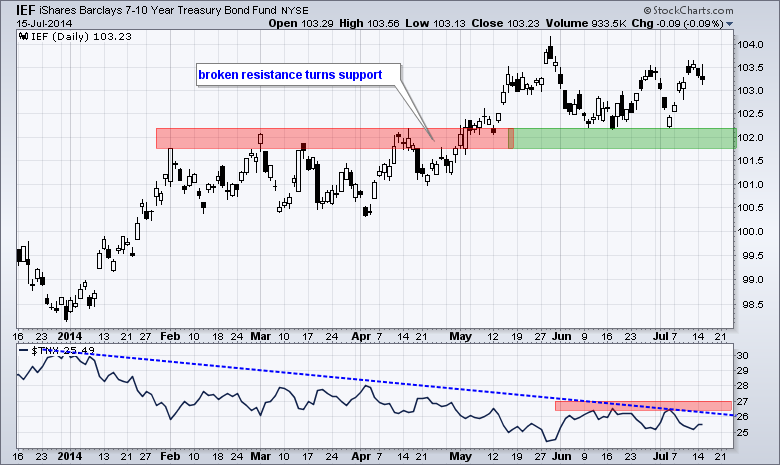Stocks, gold, the Dollar and bonds got whipped around during congressional testimony from Fed Chair Janet Yellen. Stocks opened strong, took a deep dip and the recovered some of that dip with an afternoon advance. It is hard to read into price action driven by Fed comments and the overall trends were not affected by Tuesday's price action. SPY and QQQ remain in uptrends. The Dollar broke out last week and continued higher on Tuesday. Gold broke down on Monday and continued lower on Tuesday. The 7-10 YR T-Bond ETF (IEF) was affected the most intraday with an opening surge, morning dip, late morning recovery and afternoon slide. IEF finished slightly lower on the day, but remains in an uptrend overall. On the chart below, notice that broken resistance turns support in the 102 area and the 10-YR Treasury Yield ($TNX) has resistance at 27 (2.7%). A break below 102 would reverse the uptrend in IEF and a break above 27 would reverse the downtrend in $TNX.
**This chart analysis is for educational purposes only, and should not
be construed as a recommendation to buy, sell or sell-short said securities**
*************************************************************
No change. There is no real change on the SPY chart. The ETF surged from mid May to early June and then embarked on a zigzag advance. This zigzag advance holds the key to the short-term uptrend. Right now, the late May and early June lows combine to mark a support zone in the 194-195 area. After a decline last week, SPY bounced off 195 and is attempting to form another higher low.
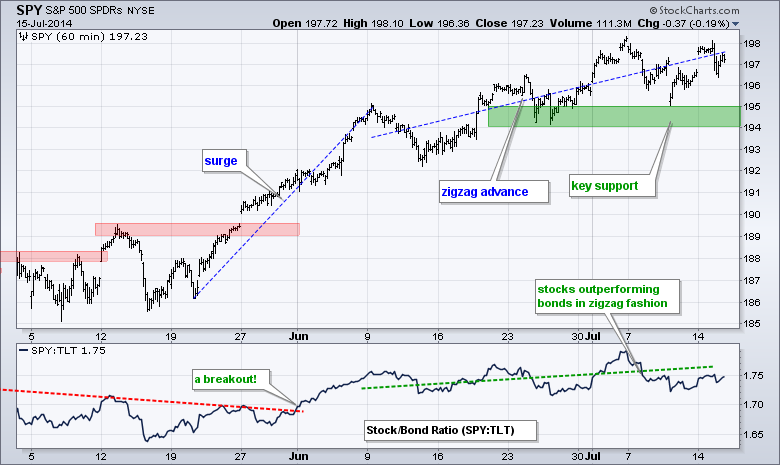
**************************************************************
No change. QQQ remains in a clear uptrend since the late May breakout. After a surge above 94 in early July, the ETF corrected with a small falling wedge. Broken resistance turned support and held in the 93.5 area last week and the ETF broke wedge resistance. This signals yet another continuation higher. I will mark first support at 93.5 and key support will remain at 92 for now.
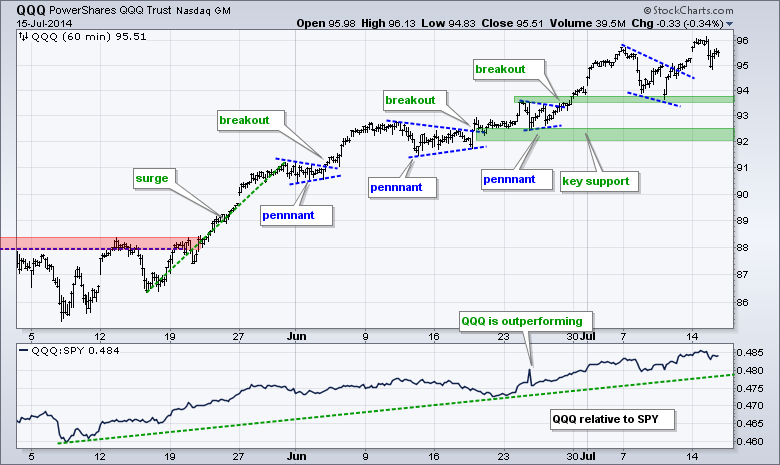
**************************************************************
No change. IWM is a tough call because SPY and QQQ remain in uptrends and this small-cap ETF has a tendency to overshoot. IWM did break support, but this decline could be corrective. The yellow zone marks potential support from broken resistance, the early June low and the 50% retracement (113-114). Broken support in the 116 area turned into resistance last week and this is the first level to watch for a breakout.
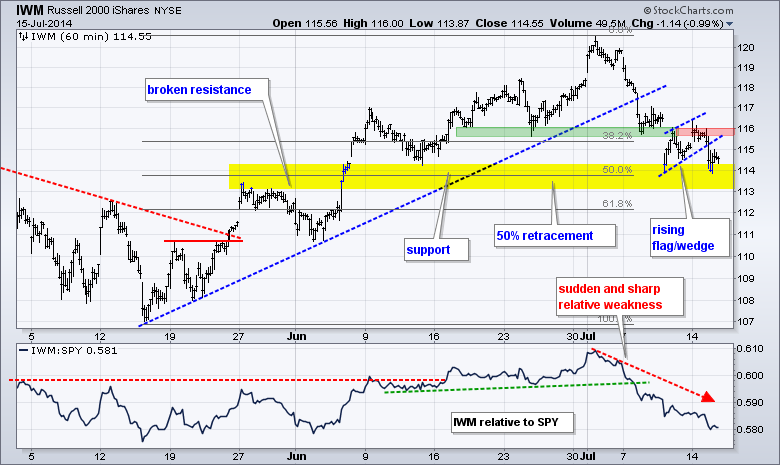
**************************************************************
No change. TLT fell sharply in early June and then turned choppy the last five weeks. Note that the ETF has been above below the 112.5 level four times in the last six weeks. The current swing is up and I am marking first support in the 112.3-112.8 area. A move below 112.3 would reverse the upswing. The 10-YR Treasury Yield is in a downswing with resistance marked at 25.5 (2.55%).
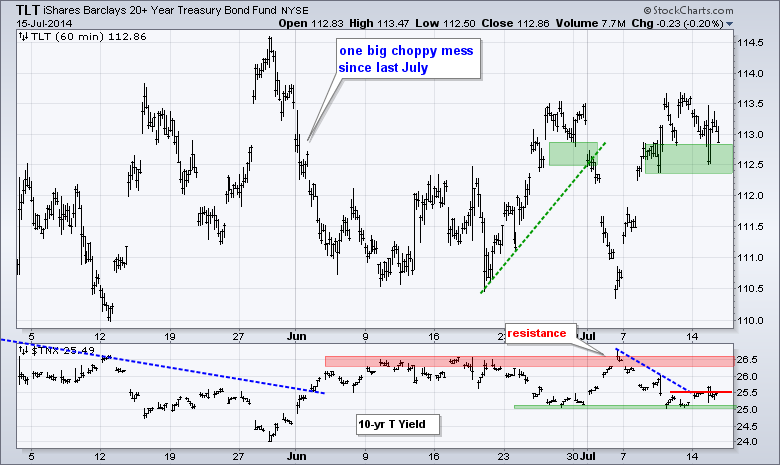
**************************************************************
No change. There is no real change in UUP. The ETF broke the early June trend line with a surge in early July and then stalled around 21.40. The trend line break is holding for the most part and I am maintaining a bullish bias on the greenback. The Euro holds an important key and remains in a downtrend overall. A breakout at 137 would be bullish for the Euro (bearish for the Dollar).

**************************************************************
No change. USO looked like it was correcting in late June, but this correction overstayed its welcome in July as the ETF exceeded the 62% retracement and moved below broken resistance at 38. This broken support zone now turns into resistance in the 38-38.3 area.
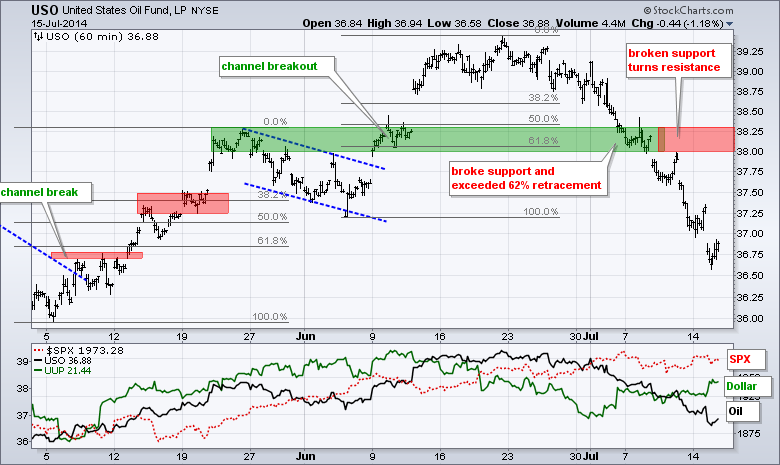
**************************************************************
GLD broke above flag resistance twice, but failed to hold both breakouts and broke support at 126 with a sharp decline. The ETF also broke the trend line extending up from early June. The failures and the support break are short-term bearish. It may be an over reaction, but chartists should treat this as bearish until proven otherwise. An immediate move back above 127.5 would argue for a reassessment.
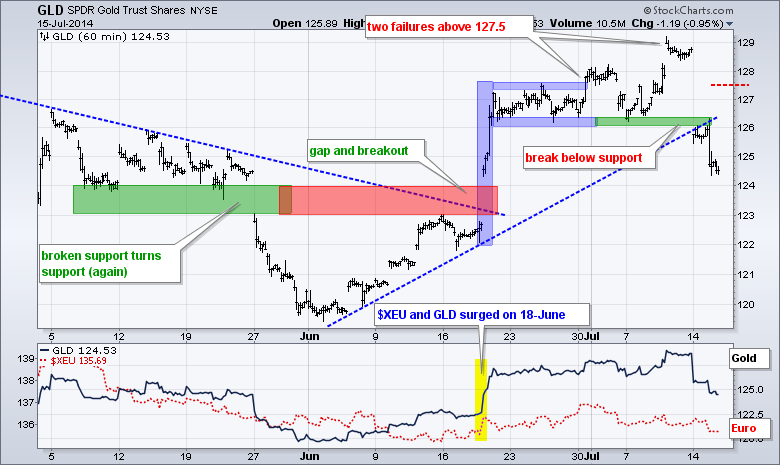
***************************************************************
Key Reports and Events (all times Eastern):
Wed - Jul 16 - 07:00 - MBA Mortgage Index
Wed - Jul 16 - 08:30 - Producer Price Index (PPI)
Wed - Jul 16 - 09:15 - Industrial Production
Wed - Jul 16 - 10:00 - NAHB Housing Market Index
Wed - Jul 16 - 10:30 - Crude Oil Inventories
Wed - Jul 16 - 14:00 - Fed Beige Book
Thu - Jul 17 - 08:30 - Initial Jobless Claims
Thu - Jul 17 - 08:30 - Housing Starts/Building Permits
Thu - Jul 17 - 10:00 - Philadelphia
Thu - Jul 17 - 10:30 - Natural Gas Inventories
Fri - Jul 18 - 09:55 - Michigan Sentiment
Fri - Jul 18 - 10:00 - Leading Economic Indicators
This commentary and charts-of-interest are designed to stimulate thinking. This analysis is not a recommendation to buy, sell, hold or sell short any security (stock ETF or otherwise). We all need to think for ourselves when it comes to trading our own accounts. First, it is the only way to really learn. Second, we are the only ones responsible for our decisions. Think of these charts as food for further analysis. Before making a trade, it is important to have a plan. Plan the trade and trade the plan. Among other things, this includes setting a trigger level, a target area and a stop-loss level. It is also important to plan for three possible price movements: advance, decline or sideways. Have a plan for all three scenarios BEFORE making the trade. Consider possible holding times. And finally, look at overall market conditions and sector/industry performance.

